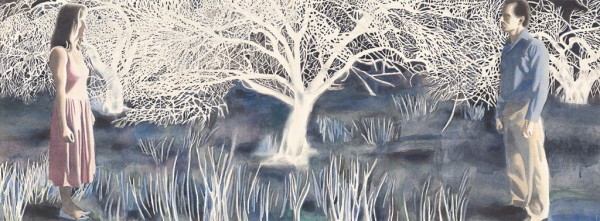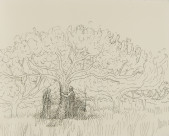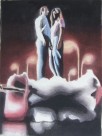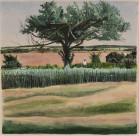Robert grew up in Nova Scotia’s Annapolis Valley, a farming district famous for its apple orchards. Orchard features a landscape that is charged with energy and tension. The image of love unfolding suggests both anxiety and compulsion. There is a mythic allusion to Adam and Eve and the forbidden tree of knowledge. However, Robert’s image departs from its Biblical source to tell the story of Elizabeth Smart’s unhappy love affair with a married writer. This image is part of a larger series of paintings, all featuring two star-crossed lovers. Like a musical composer’s “Variations,” Robert uses the same models in every image, but varies the mood and distance between the figures to create an ever-shifting impression of the original pair.
The subject of poets who break a taboo by falling in love suggests that the practitioners of art, poetry and love enter a dreamscape that is dangerous and possibly forbidden. In the traditional story of the Garden of Eden, the characters acquire knowledge about themselves, but at a cost—their separation from nature. Poets and artists see the world differently. Instead of accepting exile and taking pride in our separation from nature, poets dare to dream of reuniting with nature, of re-entering the garden. Robert’s Orchard suggests that the landscape may not symbolize an idyllic safe-haven for poetic inspiration, but rather an uncertain zone to sneak into at night at the user’s peril.



